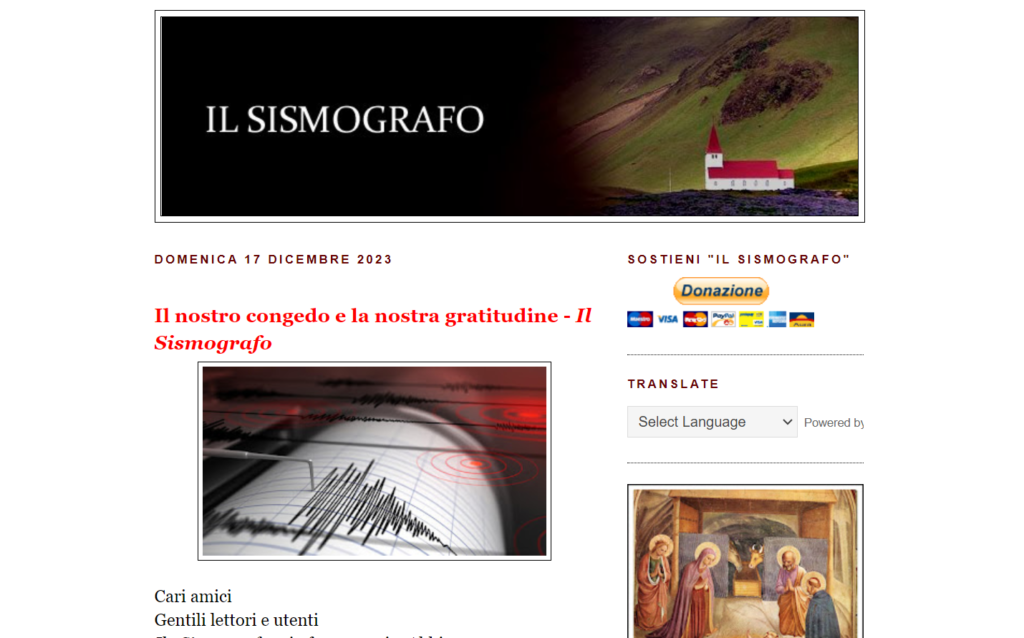ROME — Though it might be reading too much into things, it’s distinctly possible Santa Claus has drawn the conclusion that Vatican journalists were a naughty bunch this year, because just ahead of Christmas we all got a massive lump of coal in our virtual stockings.
On Dec. 17, Luis Badilla, a Rome-based Chilean journalist, announced the end of the road for his blog “Il Sismografo” (“The Seismograph”). Though he would have liked to keep going, the 78-year-old Badilla wrote in his farewell post, age and illness made it impossible.
Though I don’t know anyone who compiles statistics on such matters, I would hazard the guess that “Sismografo” probably was the single most bookmarked website among reporters who cover the Vatican for the last 15 years or so, as well as among the prelates, monsignors, and laity alike who actually work in the place.
A voracious reader and astute observer, every day Badilla would serve up an easy-to-use collection of all the important articles about the Vatican, from both mainstream news outlets and also specialized Catholic platforms, and in multiple languages: Italian, Spanish, French, English and Portuguese.
Basically, all you had to do was to spend a half-hour or so scrolling through that day’s entries, and you would be completely up to speed. As a result, Vatican-watchers everywhere are licking their chops right now, wondering what we’re going to do without “Sismografo” to rely on.
If all Badilla had done was to operate the world’s most successful Vatican news aggregator site, that alone would justify a tribute. However, “Il Sismografo” was much more than that — it was also home to his own trenchant, frequently critical musings on Vatican and Church affairs, where he pulled no punches and offered no discounts.
Badilla has been a frequent critic of Pope Francis, devoting his final “footnote,” as he called them, to a post-mortem on the Vatican “trial of the century,” which ended with the convictions of Italian Cardinal Angelo Becciu and eight other defendants, and which Badilla saw as illustrating a deep problem with the exercise of power in this papacy.
“The way, style and methods, as well as the narrative, with which Pope Bergoglio has exercised his supreme ministry as universal pastor, as bishop of Rome and successor of the apostle Peter, have highlighted that a single man in command of the Church of Christ — moreover, an absolute sovereign during his natural life — is a form of government that by now is seriously inadequate, deficient and risky,” he wrote.
“With Pope Francis, this crisis has seriously worsened, and the excesses and arbitrariness have reached intolerable limits which damage the credibility and authority of the Holy See,” Badilla wrote.
Indeed, Badilla’s skewering of this papacy has even generated suspicion in some quarters that perhaps he was closing “Il Sismografo” under Vatican pressure — or, at least, that few among Francis’ most devoted acolytes would mourn its passing.
Veteran Italian journalist Gianfranca Soldati put the theory this way: “At a certain point, ‘Sismografo’ became decidedly inconvenient, a sort of counterpoint, given that it meticulously pointed out the flaws in this pontificate with verified news and pertinent comments.”
Badilla’s “sui generis” perspective, in part, is a reflection of his remarkable biography.
Born in Chile, Badilla came from a wealthy family and attended prestigious schools, though that did not insulate him from suffering. He would later tell the story of watching his best friend at a Catholic boarding school suffer sexual abuse and eventually hang himself, which helps explain Badilla’s later passion for honesty on the Church’s abuse scandals.
Badilla trained as a medical doctor in the U.K., then returned to his native country where he became a supporter of leftist President Salvador Allende, and would later accompany the martyred leader’s wife and daughter on fundraising trips to support the opposition to Chile’s military junta.
Badilla eventually took up exile in Italy, where initially he supported himself through a variety of jobs, from nursing to bookselling. An encounter with Pope Paul VI, in which the pontiff was seeking insight about the situation in Chile, led to a job in Vatican Radio, where he would spend many years, punctuated by the occasional sabbatical — for instance, volunteering in a leper’s colony in Equatorial Guinea.
In 2006, a crisis erupted in the papacy of Benedict XVI after he lifted the excommunication of a traditionalist bishop who, it turned out, had a history of Holocaust denial, a point which somehow had escaped the attention of the pope’s advisers and media strategists. At the time, the pope’s spokesman was Father Federico Lombardi, SJ, Badilla’s old boss from Vatican Radio, and so it was that Badilla was tasked with creating a site to track coverage of the Vatican in real time.
In the beginning, “Il Sismografo” enjoyed a sort of semi-official status as a silent partner of the Vatican Press Office, so much so that ambassadors sometimes would dispatch cables to their foreign ministries based on postings on the site, regarding them as more-or-less official Vatican declarations.
Over time, however, “Il Sismografo” became progressively more independent (and influential), ending up as one of the most genuinely nonaligned platforms in the Catholic world. It was clearly not part of the hallelujah chorus of official Vatican media, but neither did it carry water for any of the organized sources of opposition. It was always, and forever, a reflection of the deeply unique perspective of its founder.
In a recent tribute, Lucetta Scaraffia, the former editor of a women’s insert to the Vatican newspaper “L’Osservatore Romano,” hailed Badilla’s zeal for the Church and for truth.
“Badilla loves the church passionately, and in all of his actions one sees the effort, a successful effort, to see the church with a critical and impartial eye, to help it do better,” she wrote.
“Badilla has become an irreplaceable witness for truly understanding something about the church of today, for whoever wants free and rigorous information that’s never sterilely critical,” Scaraffia wrote.
“Luis is always on the side of the church, and in this sense he’s still a doctor — a doctor who wants to heal it, to help it navigate its relationship with a world that’s ever more confused and conflictual, and in which facing the truth constitutes the only path of salvation.”
Fortunately, the formidable archive of “Il Sismografo” will remain available online, becoming in a sense a permanent parallel depository of records and reflections covering almost the last 20 years of Church life. At the moment, it seems that a few other outfits are already attempting to fill the void left by “Il Sismografo”; time will tell if any succeed.
In the meantime, it remains to be seen if Badilla will find other ways to make his voice heard. One hopes so, because agree with him or not, it’s impossible to deny that the Catholic conversation would be just slightly less intriguing without him.

